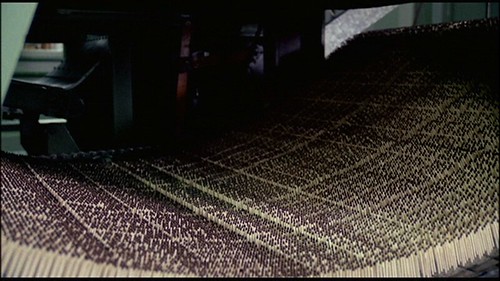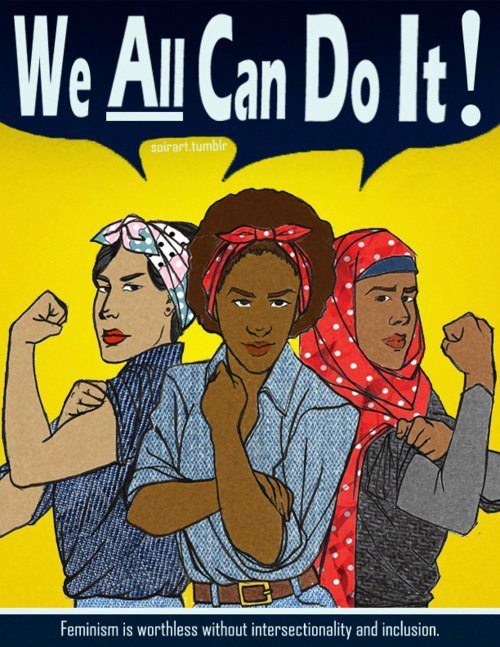This film is intensely interesting for a number of reasons, which include but are not exclusively:
- the cinematography of the film, which is consistently very well-done, fitting with the themes of isolation and middle-class hopelessness. The camera angles are often impersonal and distant, and the colors are warm, but plain and grungy enough to have a lovely aesthetic while emphasizing a certain bleakness.
- the use of music to create ironic contrasts in tone between the fantasy life of entertainment and the bleak, dull lives of the characters
- the scenes of work, eating, and dancing, which are all so mechanically set up as to draw parallels between each of the life events that Iris forces herself through
but, keeping to the theme of my blog, the main theme I will be discussing is women in film.
Iris is an interesting woman, the main character in a film that is arguably a character piece, setting up the ingredients for Iris's descent into a state that is either madness or intense clarity. Her acts of revenge at the end of the film, while shocking, flow naturally from her dull, confining life which would not be understandable if the audience were not forced to endure it with her.
The Match Factory Girl (Shadows in Paradise is not enough in line with this idea) is the only film in Kaurismäki's Proletariat Trilogy to feature a female protagonist. Thusly, her life story features challenges and attitudes that do not face the other characters in Kaurismäki's trilogy. Her life, shown as typical enough for a young woman in early 1990's Finland, centers around the two traditional forces in a woman's life: parents and romantic partner. Her life, still at her parents' house, is incredibly confining. She works a dead-end job at a match factory, just another cog in the machine, and at home she cooks for her parents and gives them the money she earns at the factory. Sometimes she is seen escaping into cheap romance novels, suitable fare for a young woman with little to dream about.
Each night she goes to a dance club and sits alone on the bench waiting to be asked to dance, which does not happen until she buys a new dress that her parents do not approve of. Even up until her ultimate rejection and discovering her pregnancy, Iris's story could be that of a thousand girls each year who live in poor circumstances, stuck in jobs they hate and unable to locate a lasting partnership or friendship to break up the tedium of working-class life. The lack of apparent meaning in Iris's life could be that of any woman or man chosen at random on a city street, hardly even worth making a movie about except as a statement about the working person as worthy of filming.
What makes Iris's story different is how it ends. It is uncertain exactly where Iris decides not to put up with the way life has treated her. It could be when her lover callously tells her to abort their child (his exact words, in a letter, are "get rid of the brat"). It could be somewhat later, when she stews on her dilemma for a while and becomes increasingly cold and calculating. It could even be when her parents kick her out of their house. Whenever this occurs, Iris's murder spree at the end is both surprising and not surprising, both uncalled for and inevitable. In the end, the workings of Iris's mind are known only to Iris, and the audience is left only grasping to understand the pain she feels at the way her life has turned out, bleak and without any apparent future. This shows itself when she poisons each of the people she feels has wronged her. First she goes to the ex-lover's house, telling him that she will take care of the situation with the child he has conceived, poisoning his drink before departing the house.
He dies, as does a young man at a bar who smiles at her. The dark comedy of his willingness to continue his drink after she pours an unidentified substance from a bottle kept in her purse illustrates the ways that men view Iris, as none see her as a threat but readily see her as something to be grasped and used.
Indeed, the final victims of poisoning also used Iris in a way--her parents, who only see her as a chef and bringer of income. She pays rent and cooks, and there is hardly a real relationship between the three, who eat all of their meals in silence.
The purpose of this article is not to pretend that The Match Factory Girl is a perfect feminist film--no, far from it. Iris attempts to escape her miserable life by attaching herself to a marriage, a traditional attempt at happiness that implies women's attachment to men is what brings their life meaning. When this is thwarted and she cannot live the ideal she reads in her books and hopes for at the dance club, hears sung about on the radio and enacted in her parents' lives, she cannot handle it and breaks down completely.
However, the way that Iris's story is handled by Kaurismäki is unique and commendable in terms of film history. Resisting any urge whatsoever to romanticize his characters, Iris is given exactly the same treatment as Kaurismäki's male protagonists. She is practical, functional, and is not sexualized in any real way. Rather, her story is entirely matter of fact, and her mental breakdown (in contrast to such films as Girl, Interrupted, Prozac Nation, and A Streetcar Named Desire) is not in the least fetishized, with no seductive camera angles or melodramatic music. In fact, her desires and needs, which, while admittedly traditionally feminine, are taken quite seriously by the film, being shown as valid and necessary. The scene in which she sees a dress she likes in a shop window and purchases it is very business-like, her transaction handled with as much integrity and gravity as an exchange with a bank teller.
Her breakdown is not tragic or romantic; rather, it is a breaking free. Even going mad, Iris is completely respectable and in control of her situation, and when Iris willingly walks off with the two police officers at the end it is almost as if she has summoned them to take her away. For a male character this would be normal; for a female character it is new and exciting. She is at once female and yet not female (in the sense most films would have it); she is her own, and inaccessible to the audience, either as tragic psychiatric case or doomed, sexy heroine. It is for this and the other described reasons that The Match Factory Girl is an exciting and innovative depiction of a female character in film, and a very progressive one at that.











